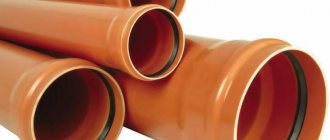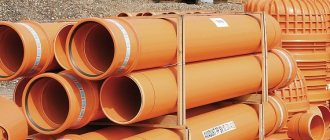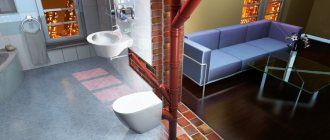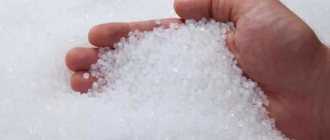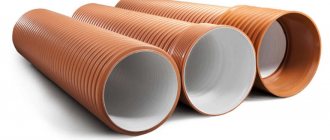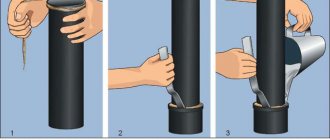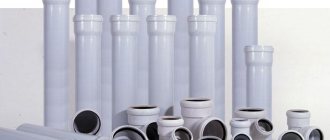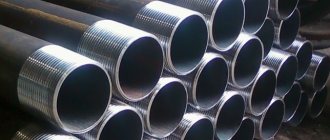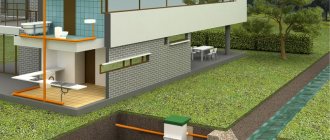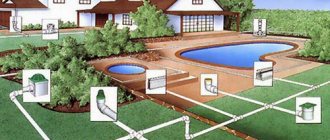A wide range of metals and polymers, as well as various combinations of them, are used in the manufacture of pipes. One of the most common types of products is polypropylene (PP) fiberglass pipe, which has found application in a number of areas of industry and public utilities.
Fiberglass used in the manufacture of pipe products serves as a heat-stabilizing and reinforcing (strengthening) layer. Thanks to the properties obtained, the scope of application of reinforced pipes has been significantly expanded.
Rice. 1 Fiberglass and fiberglass
Properties of fiberglass
Glass fiber is made from different types of glass, including broken glass. The technological process of its production consists of drawing molten glass mass (glass balls in Soviet times) through dies or inflating it with steam when ejected from a centrifuge. With the first method, a glass thread is obtained, and with the second technology, glass wool is obtained.
The resulting fiberglass has the following characteristics:
- Low thermal transfer, which is used in glass wool, the thermal conductivity of which is about 0.05 W/m °C.
- The main characteristic of glass is its increased resistance and neutrality to almost all aggressive chemicals in their high concentrations.
- The density of the glass threads themselves is 2500 kg/m3; when used with other components (plastics, resins) in a combined material, it becomes smaller.
- The melting point of glass depends on its composition and usually lies in the range from 1200 to 1400 °C.
- Glass fiber itself is a non-flammable material, but when mixed with polymers, the overall composite can become a fire hazard.
- Glass is a dielectric and is highly resistant to stray currents.
- Fiberglass is a corrosive and biologically resistant material.
- Glass threads are not inferior in strength to steel, fiberglass is much stronger than nylon.
- Depending on the thickness of the thread, several types of fiber are produced, the ultra-thin has a diameter of 1 micron, the thickest one reaches 25 microns.
Rice. 2 Materials for fiberglass production according to GOST 32650—2014
Production technology
In the pipe industry, the only glass fiber reinforced pipe is polypropylene (PP). Thanks to the technology of introducing an internal fiberglass layer into the pipe shell, the physical characteristics of the products were significantly improved.
Polypropylene pipes reinforced with glass fiber are produced in modern factories using the following technology:
- Granulated polypropylene PPR-100 from the silos in which it is stored is sent to supply bins.
- In the section for preparing fiberglass filler, fiber and polypropylene fibers are formed into bundles under the influence of high temperature. After cooling, they are crushed into granules.
- Granules of fiberglass fiber and polypropylene are conveyed through a pneumatic pipeline into the hoppers of an automated extruder line.
- After molding the pipe shell in the extruder, a three-layer reinforced pipe is obtained at its output.
- Next, the product goes through a vacuum calibrator and cooling baths.
- Afterwards, a caterpillar-type pulling device with a stable pulling speed feeds the pipe to the cutting machine.
- There, dust-free cutting of pipes with knives is carried out into pieces of the required length.
- After cutting, the finished products enter the storage facility, where they are packaged and dumped into transport carts by a pneumatically driven tipper.
Rice. 3 Technology for the production of polypropylene pipes
Why is aluminum reinforcement made?
The solution to these problems was found in the design field.
The solid polypropylene in the pipe is reinforced with reinforcing inserts. Materials with opposite mechanical properties were selected: fiberglass and metal. And the strength indicators have more than doubled - reinforced pipes are able to withstand hot water pressure of up to 20 atmospheres. In this way, a result was obtained that allowed the widespread use of aluminum-reinforced polypropylene pipes for hot water and heating plumbing systems.
The reinforcement of polypropylene with aluminum foil deserves special attention. First of all, why was aluminum chosen? A characteristic feature of this metal is the reliable protection of the surface of products made from it by an oxide film. Aluminum patina (Al2O3) is very resistant to any oxidizing agents and chemically active substances.
Only mercury salts can destroy it. Therefore, it is a reliable chemical protection for strengthening pipes. At the same time, the mechanical strength of the products is sufficient to withstand excess pressure from the transported liquid from the inside with a thickness of 0.1-0.5 millimeters.
Some other metals, such as gold, silver and platinum, fully possess similar properties. But we will not seriously consider their use in pipe production for obvious reasons.
Areas of application
The main areas of use of polypropylene pipelines are household and municipal services, food and chemical industries. In everyday life they are used for:
- Cold water supply indoors. For these purposes, a conventional PP pipe is used, in which there is no reinforcing layer. However, the use of pipes with fiber in pipelines with high pressure, which is present in networks of multi-storey buildings, cannot be ruled out.
- In hot water lines. PP pipe reinforced with glass fiber is better than others in terms of its technical characteristics and is suitable for intra-house hot water supply networks. It is the optimal choice in terms of price-quality ratio and can withstand a maximum service life at standard pressure and water temperature in the system.
- In heating system pipelines. It is worth noting that polypropylene heating pipes with fiberglass reinforcement are recommended for use in heating systems for both municipal and domestic purposes no higher than 80 ºC and a pressure (PN) of 20 or 25 bar. But not every individual heating system operates with a coolant having a heating temperature of 80 or 90 °C.
Physical and operational properties
In everyday life, a fiberglass-reinforced PP pipe is used as a heating pipe to supply heating fluid and hot water - this imposes certain restrictions on its physical characteristics and dimensional parameters. Main properties of glass fiber reinforced PP pipes:
- Random polypropylene copolymer PP-R, from which PP heating pipes are mainly made, can withstand temperatures up to 165 °C. In this case, the operating temperature of the environment at which the material can function throughout its entire operational life of 50 years should not exceed 80 °C.
- The polypropylene pipe reinforced with glass fiber is designed for operation at a nominal pressure PN of no more than 20 bar. Some manufacturers (Russian-Italian Valtec) produce PP pipes for 20 bar with a red fiberglass sheath and for 25 bar with sulfur.
- Glass fiber-reinforced PP pipes are connected by soldering, using special soldering irons for polypropylene pipes. The inner and outer shells of the two parts being soldered are heated at a temperature of + 260 °C and joined together. As a result of the mutual diffusion of polymers, a strong and reliable connection is formed. To switch to metal, any production, simultaneously with pipe products, produces a wide range of fittings, many of which are soldered with threaded brass bushings.
- The thermal conductivity coefficient of glass fiber PP pipes is relatively low and amounts to 0.25 W/m °C.
Rice. 5 Areas of application for glass fiber PP pipes from Valtec
- The standard sizes of PP pipes reinforced with glass fiber are determined by their outer diameter from the standard range of 20, 25, 32, 40, 50, 63, 75, 90 and 110 mm.
- The guaranteed and standard service life of PP pipes with fiberglass for heating is at least 50 years, provided they are used in a working environment with the temperature parameters for which they are designed (no more than + 80 ° C).
- The main disadvantage of PP pipes is the high coefficient of linear expansion, reaching up to 9 cm per 100 meters of pure polypropylene. Since the additional layer is a mixture of glass fiber and PP, linear expansion is not significantly affected. Pipe reinforced polypropylene elongates a little less (by 2 - 3 cm) when a 100 m section is heated.
- Like the vast majority of polymers, polypropylene does not tolerate direct solar radiation. To protect against ultraviolet radiation, it is painted in gray, green, and black colors.
- Also, the disadvantages of polypropylene include its high oxygen permeability, which can be harmful for pipelines and heating equipment with parts containing iron alloys.
Rice. 6 Soldering equipment for polypropylene
Reinforcement methods
When reinforced with aluminum, the foil is most often attached with an overlap. This technology is used by many domestic manufacturers. Of course, lately the butt joint of the reinforced layer has been gaining popularity. This process is performed using a special laser. When using the first method, it is necessary to strip the foil before further soldering.
At first, solid foil was used for reinforcement. This made it possible to prevent oxygen from entering the coolant, as well as to make the surface of the pipe smooth. The disadvantage was the poor connection of the reinforced layer with polypropylene. Therefore, high demands are placed on materials and connecting agents. This is especially true for the materials used to construct the heating system.
If errors were made during the production process, this will lead to a decrease in the performance characteristics of the pipe. So, this may be a violation of the production process or the use of low-quality raw materials. A common problem is moisture penetration through the top layer of polypropylene. As a result, water accumulates on the reinforced layer, which leads to the material being blown away. This significantly reduces its strength.
To avoid this result, polypropylene pipes are reinforced with perforated aluminum foil. In other words, the foil has round holes, which improves the quality of joining the layers over the entire area. Depending on the area of use, polypropylene pipes can last from 20 to 50 years. In cold water supply, such materials last longer, as they function in gentle conditions.
Central reinforcement
Polypropylene pipes made using the overlap method have some disadvantages. First of all, this concerns the installation of the pipeline. During the work process, reinforced pipes are cleaned for welding. This involves removing the aluminum and polypropylene layer. To somewhat simplify the connection of pipeline elements, manufacturers began to use central reinforcement products.
72af26d38d2f148b65da6d8f05dfeaed.jpe
The use of such products allows you to maintain their advantages. Of course, they have some disadvantages. This applies to stripping pipes before welding, which will prevent contact of the reinforced layer with the coolant. If this is not done and ordinary nozzles are used for joining, then as a result water will leak between the layers. The result is swelling of materials.
During the installation of the pipeline, it is necessary to perform high-quality trimming of the elements. This will ensure a reliable and durable connection. Unfortunately, it is quite difficult to trim pipes on an existing pipeline. This significantly reduces the quality of connections. The only option is to use special attachments that have design features.
Using the nozzle, the outer and inner surfaces are heated. This is possible thanks to a special hole in the element’s design. Air is released through it, which enters the space between the nozzle and the reinforced pipe. This hole also allows for visual control of the heating of the pipeline element.
Glass fiber reinforcement
An alternative to aluminum is fiberglass. Reinforcement is carried out using a similar technology. The difference is that fiberglass is used instead of aluminum. As a result, the reinforced pipe consists of two layers of polypropylene, between which fiberglass is placed. It is worth noting here that the layers are made monolithic, which increases the strength of the reinforced polypropylene pipe.
During the production process, the inner layer is welded to the outer and inner. Thus, polypropylene is securely bonded to fiberglass, which prevents its deformation. To connect the pipe layers, glue is not used, as was the case in the previous case.
The disadvantages of reinforcing a polypropylene pipe with glass fiber include an increase in the weight of the product. But it is worth noting that the cost of such material is somewhat lower. In addition, fiberglass does not prevent oxygen from entering the coolant. As a result, this increases the occurrence of a corrosion process on the metal elements of the system.
Fiberglass pipe - installation
The installation of polypropylene pipes with fiberglass reinforcement is no different from conventional ones - to connect individual sections, fittings and fittings, the soldering method is used at a temperature of 260 ° C.
Each manufacturer of fiberglass polypropylene pipes produces a wide range of shaped parts for soldering work. These include couplings, adapters from small to large diameter and from polypropylene to threaded brass, corner bends, tees, shut-off ball valves and a number of other shaped elements.
It is worth noting that for welding fiberglass-reinforced polypropylene pipes, the same fittings are used as for soldering conventional pipes; all fittings are universal.
There are two main types of soldering units for joining polypropylene: sword-shaped and rod-shaped. To work with large-sized elements, disc irons of large diameters are used. Although the price range of soldering irons is quite wide and the market is saturated with a large number of not very high-quality Chinese devices, a good Turkish-made device for semi-professional and household use can be purchased for only 3,000 rubles.
Rice. 7 Fittings, fittings and fittings for soldering polypropylene
The procedure for soldering polypropylene itself does not look too complicated; often, in order to save money, owners master soldering on their own and lay intra-house lines with their own hands.
To connect two polypropylene pipes of the same or different diameters on a sword-shaped soldering iron, carry out the following operations:
- Assemble the soldering device by connecting cylindrical nozzles to it on both sides.
- Plug the soldering iron into the electrical network and wait for the iron to heat up to the desired temperature - this is indicated by the indicator.
- At the same time, place a pipe and a coupling on the nozzles on both sides and hold them for some time, specified in the instructions for the soldering machine.
- Remove the pipe and coupling, quickly join them together, trying to maintain the relative position of the parts strictly along the axial line. Under no circumstances should the parts be rotated relative to each other.
- After fixing for a specified time, the joining of two elements is considered complete.
- Then the entire procedure is repeated, heating the second pipe section and the first with a soldered coupling on the nozzles.
Review of manufacturers and costs
On the Internet you can find a lot of various ratings of manufacturers of polypropylene products. These include European, Chinese, Turkish and domestic firms. The following are most often mentioned in the ratings: the German brand “Rehau”, the Italian “Valtek”, the Spanish FADO, the Czech “ECOPLASTIC”, the Turkish “TEBO”, Firat, Pilsa.
Valtec
The Italian brand Valtec offers a whole range of single- and multi-layer products of various diameters. The list of brand products includes polypropylene pipes reinforced with fiberglass, aluminum foil, and all kinds of fittings for heating, water supply and process lines.
All products are adapted to heat and water supply systems operating in the post-Soviet space. A multi-level quality control system virtually eliminates the appearance of defective products on the market.
Wavin Ekoplastic
The Czech company Wavin Ecoplastic has been manufacturing plastic pipeline systems since 1990. All of the company's products have international certification and are well known in more than fifty countries around the world.
Ecoplastic enterprises produce about 28 thousand km per year. polymer products, including hundreds of types of plastic and combined fittings.
Fado
The product range of the Italian company Fado is incredibly wide and allows you to create pipeline systems of any complexity. In addition to the polypropylene pipelines themselves, Fado offers a full range of fasteners, connecting and combined fittings, shut-off valves, manifolds and sealing materials. All products are certified in Europe and the CIS countries.
An excellent addition to piping systems is our proprietary polypropylene soldering tool.
Tebo
The Tebo brand, owned by Novoplast, produces engineered polypropylene systems. The main product type is PP-R pipes and fittings.
In their production, high-quality raw materials from the world-famous concern Borealis and Hyosang are used. All production processes are carefully controlled, and the products themselves are manufactured on modern automated lines.
Chinese manufacturers occupy the lion's share of the market. Prices for polypropylene products can vary greatly. For example, a high-quality pipe VALTEC PP - FIBER PN20 25 mm, reinforced with fiberglass, costs about $6.5 per 4-meter section, while a Chinese low-grade analogue costs half as much.
Considering the importance of various types of polypropylene communications, which should last for decades, you should choose only high-quality products from well-known manufacturers
Marking of polypropylene pipes with fiberglass
Polypropylene pipes reinforced with glass fiber are marked by leaving a longitudinal symbol strip on the outer shell.
It is worth noting that the order of arrangement and the presence of certain symbols differ among different manufacturers due to the lack of uniform standards. But any marking necessarily contains the dimensional parameters of the product and its pressure characteristics. Decoding of alphanumeric symbols in order of arrangement:
- Logo, trademark of the manufacturer.
- Product brand name
- Material of manufacture. Usually they use the standard designation - PP-R/GF/PP-R or PPR-GF-PPR (sometimes PPR-GF), where - PP-R is a random propylene copolymer; — GF — inner layer made of a mixture of polypropylene and fiberglass.
- SDR is a standard diameter to wall thickness ratio.
- S - series of pipes, shows the ratio of the outer diameter to the wall thickness. The indicator duplicates SDR and is related to it using the formula S = (SDR-1)/2.
- MRS - minimum long-term strength. It shows at what pressure the pipe can be guaranteed to serve a service life of 50 years, provided that it transports a working medium with a temperature not exceeding 20 °C.
- PN - nominal pressure, consists of the indicated symbol and number.
- Product diameter and wall thickness.
- The operating class is usually assigned to products from domestic manufacturers: - 1 - the product is designed for operation in hot water supply networks at a working environment temperature of no more than 50 °C. — 2 – for use in hot water supply lines at water temperatures up to 70 °C. — 3 – the product is suitable for use in low-temperature radiator heating with a heating fluid temperature of no more than 50 °C. – 4 – the pipe is intended for use in high-temperature radiator heating with a coolant temperature of up to 70 °C. — 5 – the product is designed for use in underfloor heating at a working environment temperature of no more than 90 °C. — HV – pipe is intended for use in cold water supply networks.
- Specifications, normative document or standard.
- Factory information: shift, batch, production date.
- Product barcode.
- Manufacturer country.
Rice. 9 Examples of marking PP pipes
Related article:
Autonomous heating system for a private house - a complete guide . How to properly organize an autonomous heating system, what materials and equipment to choose, how to organize everything correctly, what documents will be needed.

